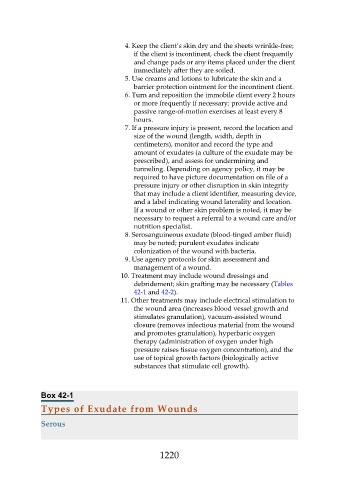Page 1220 - Saunders Comprehensive Review For NCLEX-RN
P. 1220
4. Keep the client’s skin dry and the sheets wrinkle-free;
if the client is incontinent, check the client frequently
and change pads or any items placed under the client
immediately after they are soiled.
5. Use creams and lotions to lubricate the skin and a
barrier protection ointment for the incontinent client.
6. Turn and reposition the immobile client every 2 hours
or more frequently if necessary; provide active and
passive range-of-motion exercises at least every 8
hours.
7. If a pressure injury is present, record the location and
size of the wound (length, width, depth in
centimeters), monitor and record the type and
amount of exudates (a culture of the exudate may be
prescribed), and assess for undermining and
tunneling. Depending on agency policy, it may be
required to have picture documentation on file of a
pressure injury or other disruption in skin integrity
that may include a client identifier, measuring device,
and a label indicating wound laterality and location.
If a wound or other skin problem is noted, it may be
necessary to request a referral to a wound care and/or
nutrition specialist.
8. Serosanguineous exudate (blood-tinged amber fluid)
may be noted; purulent exudates indicate
colonization of the wound with bacteria.
9. Use agency protocols for skin assessment and
management of a wound.
10. Treatment may include wound dressings and
debridement; skin grafting may be necessary (Tables
42-1 and 42-2).
11. Other treatments may include electrical stimulation to
the wound area (increases blood vessel growth and
stimulates granulation), vacuum-assisted wound
closure (removes infectious material from the wound
and promotes granulation), hyperbaric oxygen
therapy (administration of oxygen under high
pressure raises tissue oxygen concentration), and the
use of topical growth factors (biologically active
substances that stimulate cell growth).
Box 42-1
Types of Exudate from Wounds
Serous
1220

